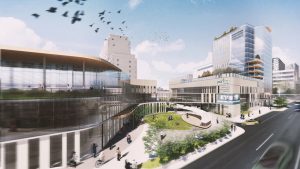Winnipeg Coun. Brian Mayes wants the city to produce a map that will show where it intends to allow fourplexes up to four-storeys to be built within 800 metres of high frequency transit corridors — but without the usual public hearing.
The proposed changes are one of eight initiatives for in Winnipeg.
In November 2023, the federal government agreed to give Winnipeg $122.4 million through its Housing Accelerator Fund.
In return, council agreed to a number of initiatives meant to speed up housing construction as-of-right.
As-of-right means property owners would not need to apply for re-zoning or variances, which include an open hearing and a vote by city councillors.
A draft of a map shown to councillors last year showed the as-of-right rule would apply to much of the city.
Mayes, who represents St. Vital, a mostly residential ward on the east side of the Red River, says he wants to see a map now.
He says the proposed changes could affect many Winnipeggers, including the residents of his ward.
“Staff haven’t spelled out the city’s plans,” says Mayes. “My constituents are waking up to the fact there will be new stuff in St. Vital and they want to find out the details.
“There’s place-making and there’s place-unmaking. There must be some changes, we accept that, but a four-storey building doesn’t belong in the middle of a block of one-storey bungalows.”
Mayes says he’s concerned residents won’t have enough notice ahead of a public hearing, scheduled for early 2025, on the zoning changes.
Mayes isn’t the only city councillor who has his doubts about how the proposed zoning changes will work out for Winnipeg residents.
“I don’t expect the zoning changes or the federal money will result in any of the housing that’s needed in my part of the city, because of all the crime and social disorder there,” says Coun. Ross Eadie, who represents the north end Mynarski ward. “No developer will build there because he won’t be able to charge high enough rents to make his investment worthwhile.”
Eadie says any new housing that results from the federal money or zoning changes will be built in areas of the city that have less crime and few or no vacant or derelict buildings.¬Ý
“My ward needs affordable housing, but this initiative won’t bring it about,” he says.
The head of the (MHBA), on the other hand, is more positive about the deal between Ottawa and the city government.
‚ÄúThe changes are necessary to modernize our zoning bylaws,” says MHBA president and CEO Lanny McInnes. ‚ÄúThey haven‚Äôt been touched for quite a long time, and they‚Äôre not in step with Winnipeg’s planning documents.‚Äù
Jino Distasio, professor of urban geography at the University of Winnipeg, is also in favour of the proposed zoning changes.
“The city has a limited ability to affect the supply of housing in Winnipeg,” says Distasio. “But it can make it easier for developers by streamlining the development process, reducing red tape and making the process more efficient.”
Distasio says Winnipeggers shouldn’t expect to see a sudden stampede to infill housing “anywhere and everywhere.”
“The development that is encouraged by the proposed zoning changes will help the city flourish in areas where it makes economic sense,” he says.
Initiative doubters shouldn’t feel unduly worried.
“Despite the zoning changes and the as-of-right principle, there are still guidelines and policies that developers must follow,” Distasio says. “They can’t just put up anything anywhere they feel like it. The city released new infill guidelines recently that spell out the parameters for infill projects.”
The Ottawa-Winnipeg deal is one-of-a-kind, says Distasio.
“What’s unique is the federal government going directly to a municipality – which is a creature of the provincial government – and offering it money in exchange for making changes in their zoning,” he says. “I haven’t seen that before.”
University of Winnipeg professor of political science Aaron Moore says the city might have had an ulterior motive for signing on to the deal with the federal government.
Moore says what the city might have really been after is access to money to pay for badly needed infrastructure.
“Winnipeg wants money for infrastructure, and some of the feds’ $122 million can go towards that,” he says.
Apart from that, Moore doesn’t like the deal.
“It’s far too heavy-handed by the city,” he says. “It reduces the citizens’ role in consulting on development, and it will lead to more congestion and more demand for services in some areas of the city.”





Recent Comments
comments for this post are closed